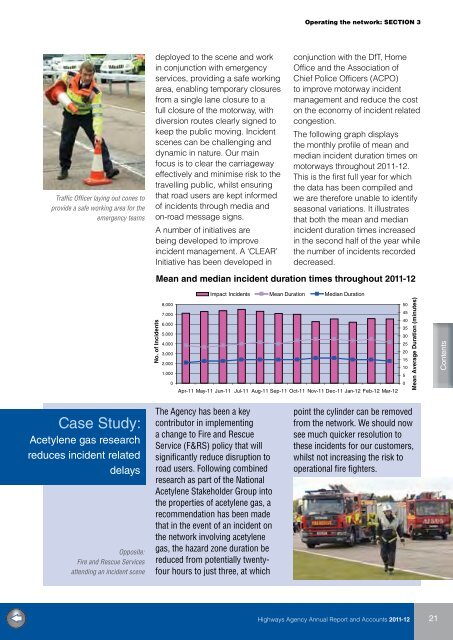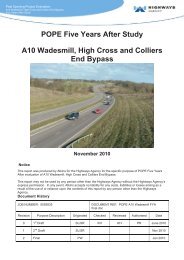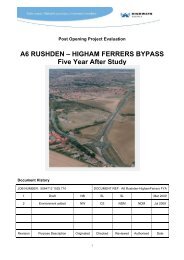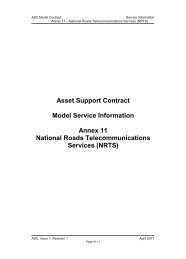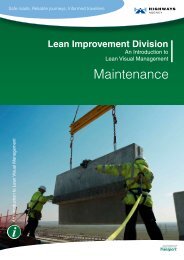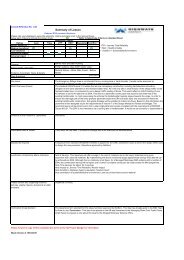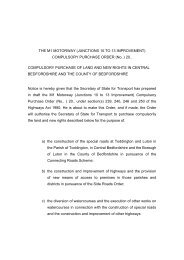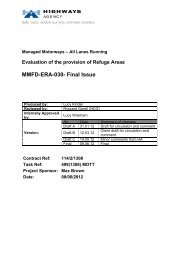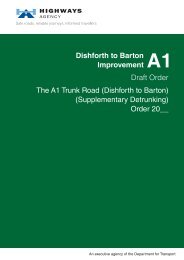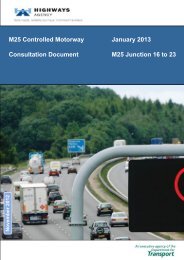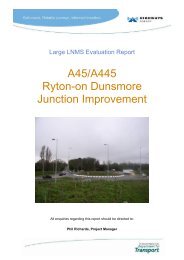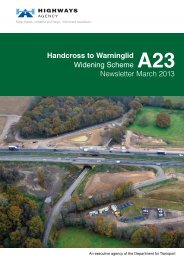Highways Agency Annual Report and Accounts 2011-2012
Highways Agency Annual Report and Accounts 2011-2012
Highways Agency Annual Report and Accounts 2011-2012
You also want an ePaper? Increase the reach of your titles
YUMPU automatically turns print PDFs into web optimized ePapers that Google loves.
Operating the network: SECTION 3<br />
Traffic Officer laying out cones to<br />
provide a safe working area for the<br />
emergency teams<br />
deployed to the scene <strong>and</strong> work<br />
in conjunction with emergency<br />
services, providing a safe working<br />
area, enabling temporary closures<br />
from a single lane closure to a<br />
full closure of the motorway, with<br />
diversion routes clearly signed to<br />
keep the public moving. Incident<br />
scenes can be challenging <strong>and</strong><br />
dynamic in nature. Our main<br />
focus is to clear the carriageway<br />
effectively <strong>and</strong> minimise risk to the<br />
travelling public, whilst ensuring<br />
that road users are kept informed<br />
of incidents through media <strong>and</strong><br />
on-road message signs.<br />
A number of initiatives are<br />
being developed to improve<br />
incident management. A ‘CLEAR’<br />
Initiative has been developed in<br />
conjunction with the DfT, Home<br />
Office <strong>and</strong> the Association of<br />
Chief Police Officers (ACPO)<br />
to improve motorway incident<br />
management <strong>and</strong> reduce the cost<br />
on the economy of incident related<br />
congestion.<br />
The following graph displays<br />
the monthly profile of mean <strong>and</strong><br />
median incident duration times on<br />
motorways throughout <strong>2011</strong>-12.<br />
This is the first full year for which<br />
the data has been compiled <strong>and</strong><br />
we are therefore unable to identify<br />
seasonal variations. It illustrates<br />
that both the mean <strong>and</strong> median<br />
incident duration times increased<br />
in the second half of the year while<br />
the number of incidents recorded<br />
decreased.<br />
Mean <strong>and</strong> median incident duration times throughout <strong>2011</strong>-12<br />
No. of Incidents<br />
8,000<br />
7,000<br />
6,000<br />
5,000<br />
4,000<br />
3,000<br />
2,000<br />
1,000<br />
0<br />
Impact Incidents Mean Duration Median Duration<br />
Apr-11 May-11 Jun-11 Jul-11 Aug-11 Sep-11 Oct-11 Nov-11 Dec-11 Jan-12 Feb-12 Mar-12<br />
50<br />
45<br />
40<br />
35<br />
30<br />
25<br />
20<br />
15<br />
10<br />
5<br />
0<br />
Mean Average Duration (minutes)<br />
Case Study:<br />
Acetylene gas research<br />
reduces incident related<br />
delays<br />
Opposite:<br />
Fire <strong>and</strong> Rescue Services<br />
attending an incident scene<br />
The <strong>Agency</strong> has been a key<br />
contributor in implementing<br />
a change to Fire <strong>and</strong> Rescue<br />
Service (F&RS) policy that will<br />
significantly reduce disruption to<br />
road users. Following combined<br />
research as part of the National<br />
Acetylene Stakeholder Group into<br />
the properties of acetylene gas, a<br />
recommendation has been made<br />
that in the event of an incident on<br />
the network involving acetylene<br />
gas, the hazard zone duration be<br />
reduced from potentially twentyfour<br />
hours to just three, at which<br />
point the cylinder can be removed<br />
from the network. We should now<br />
see much quicker resolution to<br />
these incidents for our customers,<br />
whilst not increasing the risk to<br />
operational fire fighters.<br />
<strong>Highways</strong> <strong>Agency</strong> <strong>Annual</strong> <strong>Report</strong> <strong>and</strong> <strong>Accounts</strong> <strong>2011</strong>-12


